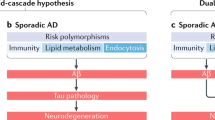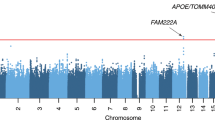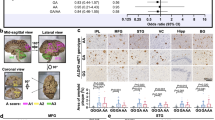Abstract
The CST3 Thr25 allele of CST3, which encodes cystatin C, leads to reduced cystatin C secretion and conveys susceptibility to Alzheimer's disease. Here we show that overexpression of human cystatin C in brains of APP-transgenic mice reduces cerebral amyloid-β deposition and that cystatin C binds amyloid-β and inhibits its fibril formation. Our results suggest that cystatin C concentrations modulate cerebral amyloidosis risk and provide an opportunity for genetic risk assessment and therapeutic interventions.
This is a preview of subscription content, access via your institution
Access options
Subscribe to this journal
Receive 12 print issues and online access
$209.00 per year
only $17.42 per issue
Buy this article
- Purchase on Springer Link
- Instant access to full article PDF
Prices may be subject to local taxes which are calculated during checkout


Similar content being viewed by others
References
Levy, E. et al. Brain Pathol. 16, 60–70 (2006).
Herzig, M.C. et al. Nat. Neurosci. 7, 954–960 (2004).
Radde, R. et al. EMBO Rep. 7, 940–946 (2006).
Selenica, M.L. et al. Scand. J. Clin. Lab. Invest. 67, 179–190 (2007).
Balbin, M. et al. Biol. Chem. Hoppe Seyler 373, 471–476 (1992).
Finckh, U. et al. Arch. Neurol. 57, 1579–1583 (2000).
Cathcart, H.M. et al. Neurology 64, 755–757 (2005).
Bertram, L. et al. Nat. Genet. 39, 17–23 (2007).
Benussi, L. et al. Neurobiol. Dis. 13, 15–21 (2003).
Paraoan, L. et al. Traffic 5, 884–895 (2004).
Eriksson, P. et al. Arterioscler. Thromb. Vasc. Biol. 24, 551–557 (2004).
Chuo, L.J. et al. Dement. Geriatr. Cogn. Disord. 23, 251–257 (2007).
Ghidoni, R. et al. Neurobiol. Aging 28, 371–376 (2007).
Bjarnadottir, M. et al. Amyloid 8, 1–10 (2001).
Filler, G. et al. Clin. Biochem. 38, 1–8 (2005).
Acknowledgements
We would like to thank H. Blöndal (University of Reykjavik, Iceland) and M. Tolnay (University of Basel, Switzerland) for the tissue of individuals with HCHWA-I and Alzheimer's disease, respectively, and L. Mucke (Gladstone Institute, San Francisco, California) for the GFAP promoter. The experimental help of T. Herbert (Institute for Biometry, Tübingen, Germany), M. Mittelbronn (Institute of Neuropathology, Tübingen, Germany), T. Bolmont, Z. Gao, C. Schäfer, J. Odenthal and R. Radde (Hertie Institute, Tübingen, Germany) are gratefully acknowledged. We also thank L. Walker (Emory University, Atlanta, Georgia) and L. Bertram (Massachusetts General Hospital Institute of Neurodegenerative Disease, Charlestown, Massachusetts) for valuable comments on this manuscript. This work was supported by grants to M.J. from BMBF (NGFN2 and 01GU0522-ARREST-AD), EU contract LSHM-CT-2003-503330 (APOPIS), and to A.G. from the Swedish Research Council (05196).
Author information
Authors and Affiliations
Contributions
S.A.K., with the help of M.C.H., performed the experimental work with the exception of the gel filtration assays, which were done by M.-L.S. and A.G. The cystatin C transgenic mice were generated by J.C and D.T.W. with the help of E.K. and M.S. The APP23 and CysC knockout mice were provided by M.S. and A.G., respectively. A.G. provided the recombinant cystatin C. E.L. was key to the initiation of this study and provided the cystatin C constructs. M.J. designed and supervised the study. The manuscript was finalized by M.J. with the assistance of all coauthors.
Corresponding author
Supplementary information
Supplementary Text and Figures
Supplementary Table 1, Supplementary Figures 1–5, Supplementary Methods (PDF 4026 kb)
Rights and permissions
About this article
Cite this article
Kaeser, S., Herzig, M., Coomaraswamy, J. et al. Cystatin C modulates cerebral β-amyloidosis. Nat Genet 39, 1437–1439 (2007). https://doi.org/10.1038/ng.2007.23
Received:
Accepted:
Published:
Issue Date:
DOI: https://doi.org/10.1038/ng.2007.23
This article is cited by
-
Cerebrospinal fluid shotgun proteomics identifies distinct proteomic patterns in cerebral amyloid angiopathy rodent models and human patients
Acta Neuropathologica Communications (2024)
-
Serum Cystatin C is a potential biomarker for predicting amyotrophic lateral sclerosis survival
Neurological Sciences (2024)
-
Human cystatin C induces the disaggregation process of selected amyloid beta peptides: a structural and kinetic view
Scientific Reports (2023)
-
Extracellular protein components of amyloid plaques and their roles in Alzheimer’s disease pathology
Molecular Neurodegeneration (2021)
-
Transcriptomic profiling of microglia and astrocytes throughout aging
Journal of Neuroinflammation (2020)



